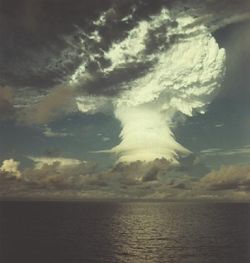TNT equivalent: Difference between revisions
Jump to navigation
Jump to search

John Leach (talk | contribs) |
Pat Palmer (talk | contribs) m (Text replacement - "explosive" to "explosive") |
||
| Line 2: | Line 2: | ||
{{Image|Mike, H-bomb, 10.4 Mt, Enewetak, Oct. 31, 1952.JPG|right|250px|10.4 Mt of TNT equivalent, "Mike" surface test of first fusion device. Enewetak Atoll,Marshall Islands, Pacific Ocean, October 31, 1952.}} | {{Image|Mike, H-bomb, 10.4 Mt, Enewetak, Oct. 31, 1952.JPG|right|250px|10.4 Mt of TNT equivalent, "Mike" surface test of first fusion device. Enewetak Atoll,Marshall Islands, Pacific Ocean, October 31, 1952.}} | ||
The '''TNT equivalent''' is a unit of [[Energy (science)|energy]] commonly used to quantify the energy released (or "yielded") in [[Explosives|explosions]]. The ton (or tonne)<ref name=ton group=note/> of TNT equivalent is equal to 4.184 gigajoules (GJ)<ref name=NIST/> which is approximately the amount of energy released in the [[detonation]] of one ton of [[TNT (explosive)|TNT]]<ref name=TNT group=note/> | The '''TNT equivalent''' is a unit of [[Energy (science)|energy]] commonly used to quantify the energy released (or "yielded") in [[Explosives|explosions]]. The ton (or tonne)<ref name=ton group=note/> of TNT equivalent is equal to 4.184 gigajoules (GJ)<ref name=NIST/> which is approximately the amount of energy released in the [[detonation]] of one ton of [[TNT (explosive)|TNT]]<ref name=TNT group=note/> explosive. | ||
The units, kiloton and megaton of TNT, have commonly been used to rate the energy yield, and hence destructive power, of nuclear weapons. These units have been used in various nuclear weapon control treaties<ref name=treaty/> as well as in numerous article and books. | The units, kiloton and megaton of TNT, have commonly been used to rate the energy yield, and hence destructive power, of nuclear weapons. These units have been used in various nuclear weapon control treaties<ref name=treaty/> as well as in numerous article and books. | ||
Revision as of 08:01, 4 May 2024
The TNT equivalent is a unit of energy commonly used to quantify the energy released (or "yielded") in explosions. The ton (or tonne)[note 1] of TNT equivalent is equal to 4.184 gigajoules (GJ)[1] which is approximately the amount of energy released in the detonation of one ton of TNT[note 2] explosive.
The units, kiloton and megaton of TNT, have commonly been used to rate the energy yield, and hence destructive power, of nuclear weapons. These units have been used in various nuclear weapon control treaties[2] as well as in numerous article and books.
Amounts, symbols and energy yields
Various tonnages of TNT equivalent energy and their commonly used energy yield expressions are tabulated below:
| Amount of TNT equivalent |
Symbol | Energy yield (three equal expressions) | ||
|---|---|---|---|---|
| 1 ton | t | 4.184 gigajoules | 4.184 GJ | 4.184×109 J |
| 1 kiloton | kt | 4.184 terajoules | 4.184 TJ | 4.184×1012 J |
| 1 megaton | Mt | 4.184 petajoules | 4.184 PJ | 4.184×1015 J |
| 1 gigaton | Gt | 4.184 exajoules | 4.184 EJ | 4.184×1018 J |
Some example usages
- The Massive Ordinance Air Blast (MOAB) bomb, the largest conventional bomb ever produced in the United States of America, has a TNT equivalent energy yield of approximately 11 tons (11 t).
- The W54 nuclear warhead device, now retired, developed by the United States in the early 1962s, had a TNT equivalent energy yield of 10 to 20 tons (10 to 20 t) and was probably the smallest nuclear device ever produced in the United States.
- The code-named Little Boy atom bomb air-dropped by the United States on Hiroshima, Japan in World War II had a TNT equivalent energy yield of approximately 15 kilotons (15 kt).
- During the Cold War that followed World War II, the United States tested a nuclear weapon that had a TNT equivalent energy yield of 15 megatons (Mt) and the Soviet Union tested a nuclear weapon with a TNT equivalent energy yield of 50 megatons (Mt).
- The magnitude 9.0 Tohoku-Oki earthquake that occurred off the east coast of Japan on March 11, 2011 has been estimated to have released 9.1×1018 joules which amounts to TNT equivalent of 2,175 megatons (Mt) or 2.175 gigatons (Gt).[3]
Notes
- ↑ The "ton" usually refers to the "short ton" that is a U.S. customary unit equal to 2,000 pounds which, in turn, equals 0.907 tonne (the metric ton which is 1,000 kilograms). In the context of using TNT equivalents, a ton is taken to be synonymous with a tonne and both are defined as being equal to 1,000 kilograms.
- ↑ TNT is trinitrotoluene, an explosive chemical compound with the formula C6H2(NO2)3CH3. Its IUPAC name is 2-methyl-1,3,5-trinitrobenzene.
References
- ↑ NIST Guide to SI Units, Appendix B.8 Factors for Units Listed Alphabetically NIST defines the ton of TNT equivalent as being exactly 4.184 GJ.
- ↑ F.A. Long (October 1976). "Peaceful Nuclear Explosions". The Bulletin of the Atomic Scientists 32 (8): pp. 18-28.
- ↑ Satoshi Ide, Annemarie Baltay and Gregory C. Beroza (May 19, 2011 online). "Shallow Dynamic Overshoot and Energetic Deep Rupture in the 2011 Mw 9.0 Tohoku-Oki Earthquake". Science.
